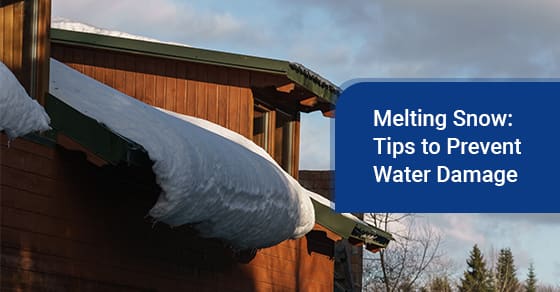
Melting Snow: Tips to Prevent Water Damage
Posted by on Jan 20, 2020 in
Many homeowners are unaware of the dangers their homes face once winter arrives. The uncertain weather of winter can lead to costly damage caused by leaks and even flooding. Depending on the source of the damage, your home insurance might not cover the cost of repairs. Although you have no control over the constant changes in winter weather, there are some precautions you can take to prevent winter water damage to your home. Here we offer some basic tips to keep your house warm and dry this winter.
Avoid Sewer Backup
One of the messiest issues you can run into during the winter is backups from the local sewer system. To avoid this issue, you can speak to a plumber about installing a sewer backup prevention valve on the mainline of your home. These valves are designed to only allow water to flow away from your home.Install a Leak Monitor
Today, water monitors can be installed to alert you when a leak occurs. When the monitors detect moisture, they send an alert and then shut off the water supply, so water damage is unlikely to occur.Inspect Plumbing
In the fall, arrange to have a plumber come in to check for signs of plumbing damage and risks. They can make repairs and provide insulation for pipes that are exposed to the cold to avoid freezing. When pipes freeze, they can burst and cause major flooding. You can conduct a few inspections throughout your home to look for leak risks. Begin with your washing machine and dishwasher hoses to look for signs of damage or old rubber hoses connected to your water. Replace them—or have a plumber—replace them with new, sturdier steel braided hoses. Next, look at your water supply lines every so often throughout the winter to see if there are any signs of leaks and make sure the connections are nice and tight. Last, check your bathtub and shower to see if they could use a new bead of caulking to keep them sealed; use waterproof caulking made for bathrooms.Prevent Drain Backups
Drain backups can lead to messy overflows. In the kitchen, you can prevent drain clogs and backups by avoiding pouring fats, oils and grease down your sink. You can also watch for issues such as slow drainage in your kitchens and bathrooms, clogs or even gurgling sounds and unpleasant smells as they are all signs your drains could be due for a professional cleaning.Watch the Weather
Keep an eye on weather reports so you can manage potential issues. When you hear cold weather warnings, run warm water occasionally to keep pipes from freezing. You should also reduce using water if you are experiencing heavy rain or when there is a drastic rise in temperature that will cause rapid thawing. This will reduce pressure on sewage systems which in turn reduces the risk for water back-up. When there is a lot of rain, or snow outside and temperatures rise, you should also check your basement for signs of leaks.Drain Outdoor Pipes
In the fall, reduce the risk of burst, frozen pipes by draining all your outdoor pipes and garden hoses. You should also check your garage to see if you have an outdoor pipe there, as these are often overlooked.Remove Debris
There are many areas outside your home that will need to be cleared of debris including:- Storm sewer grates
- Eavestroughs
- Gutters
- Main drain pipes

